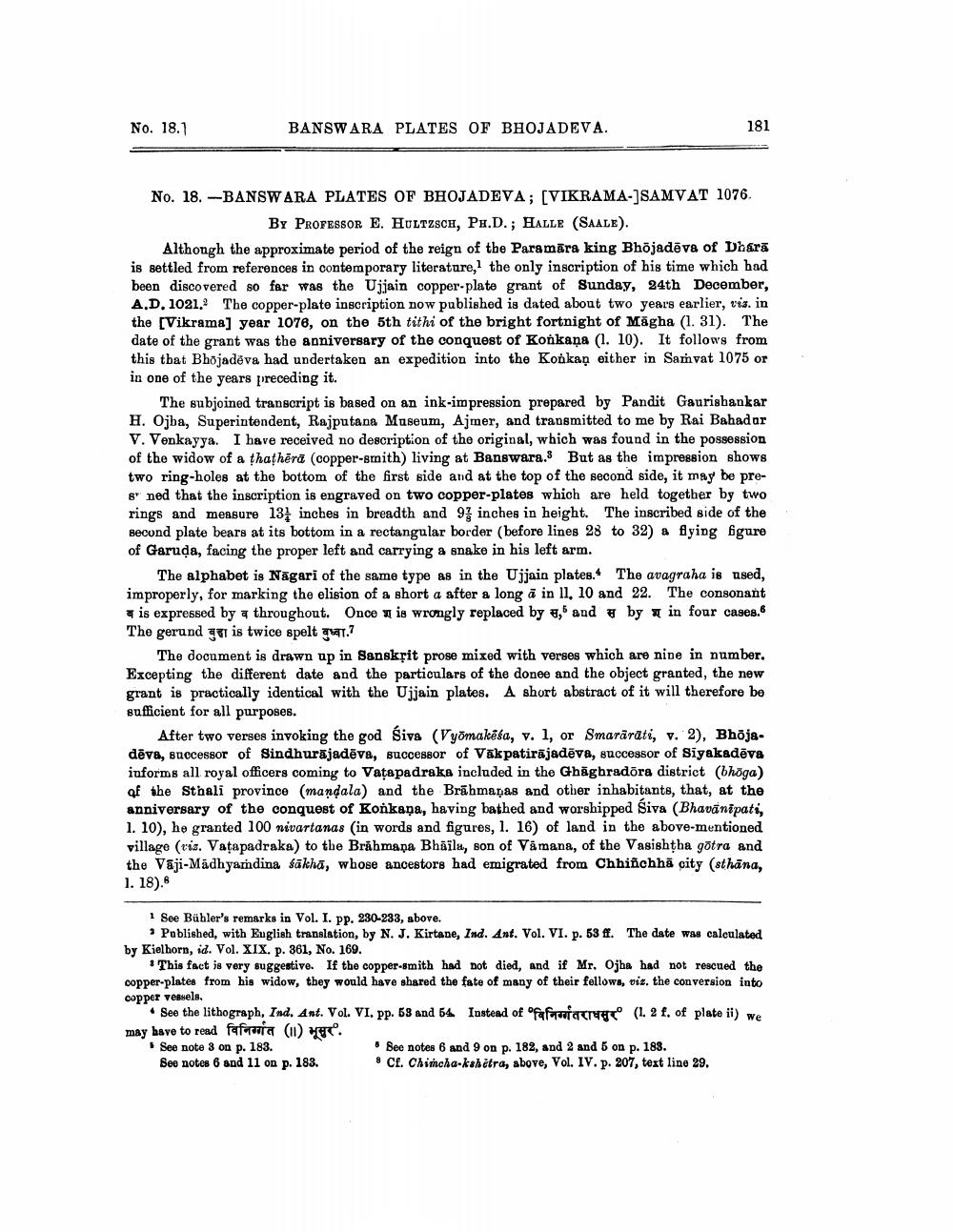________________
No. 18.1
BANSWARA PLATES OF BHOJADEVA.
181
No. 18. ---BANSWARA PLATES OF BHOJADEVA; [VIKRAMA-]SAMVAT 1076.
BY PROFESSOR E. HULTZSCH, PH.D.; HALLE (SAALE). Althongh the approximate period of the reign of the Paramāra king Bhöjadēva of Daarā is settled from references in contemporary literature, the only inscription of his time which had been discovered so far was the Ujjain copper-plate grant of Sunday, 24th December, A.D. 1021.2 The copper-plate inscription now published is dated about two year's earlier, vis. in the (Vikrama] year 1076, on the 5th tithi of the bright fortnight of Mägha (1. 31). The date of the grant was the anniversary of the conquest of Konkaņa (1. 10). It follows from this that Bhojadeva had undertaken an expedition into the Konkaņ either in Samvat 1075 or in one of the years preceding it.
The subjoined transcript is based on an ink-impression prepared by Pandit Gaurishankar H. Ojba, Superintendent, Rajputana Museum, Ajmer, and transmitted to me by Rai Bahadar V. Venkayya. I have received no description of the original, which was found in the possession of the widow of a thathērā (copper-smith) living at Banswara. But as the impression shows two ring-holes at the bottom of the first side and at the top of the second side, it may be preE' ned that the inscription is engraved on two copper-plates which are held together by two rings and measure 137 inches in breadth and 97 inches in height. The inscribed side of the second plate bears at its bottom in a rectangular border (before lines 28 to 32) & flying figure of Garuda, facing the proper left and carrying a snake in his left arm.
The alphabet is Nagari of the same type as in the Ujjaia plates. The avagraha is used, improperly, for marking the elision of a short a after a long ā in 11. 10 and 22. The consonant
is expressed by a throughout. Once u is wrongly replaced by, and by u in four cases. The gerund बुडा is twice spelt वुध्वा.'
The document is drawn up in Sanskrit prose mixed with verses which are nine in number. Excepting the different date and the particulars of the donee and the object granted, the new grant is practically identical with the Ujjain plates. A short abstract of it will therefore be sufficient for all purposes.
After two verses invoking the god Śiva (Vyomakësa, v. 1, or Smarärate, v. 2), Bhoja. dēva, successor of Sindhurajadēva, successor of Vāk patirājadēva, successor of Siyakadēva informs all royal officers coming to Vaţapadraka included in the Ghāghradora district (bhoga) of the Sthali province (mandala) and the Brāhmaṇas and other inhabitants, that, at the anniversary of the conquest of Konkaņa, having bathed and worshipped Siva (Bhavānipati, 1. 10), he granted 100 nivartanas (in words and figures, 1. 16) of land in the above-mentioned village (riz. Vatapadraka) to the Brāhmaṇa Bhāïla, son of Vámana, of the Vasishtha götra and the Vaji-Madhyamdina sākha, whose ancestors had emigrated from Chhinchha city (sthāna, 1. 18).
1 See Bühler's remarks in Vol. I. pp. 230-233, above.
» Published, with Euglish translation, by N. J. Kirtane, Ind. Ant. Vol. VI. p. 53 ff. The date was calculated by Kielhorn, id. Vol. XIX. p. 361, No. 169.
* This fact is very suggestive. If the copper-smith had not died, and if Mr. Ojha had not rescued the copper-plates from his widow, they would have shared the fate of many of their fellows, vis, the conversion into copper Vessels.
• See the lithograph, Ind. Ant. Vol. VI. pp. 53 and 54 Instead of "fa formare (12 f. of plate ii) we may have to read fafara (11) See note 3 on p. 183.
. See notes 6 and 9 on p. 182, and 2 and 5 on p. 188. See notes 6 and 11 on p. 183. 8 Cf. Chimcha-kahētra, above, Vol. IV. p. 207, text line 29.




